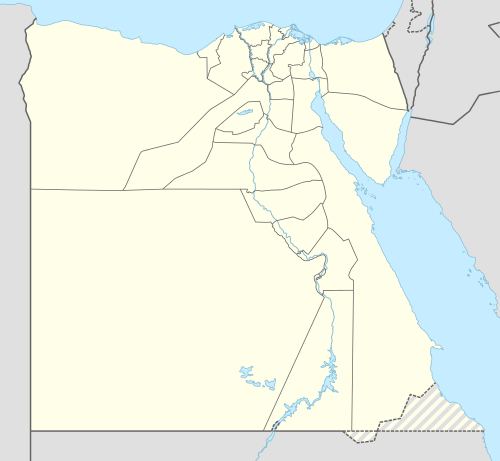Tahpanhes
Coordinates: 30°51′38″N 32°10′17″E / 30.86056°N 32.17139°E
| Tahpanhes Tahapanes Tehaphnehes Daphnae (ancient Greek) Tell Defenneh | |
|---|---|
| Ancient city | |
 Tahpanhes Location in Egypt | |
| Coordinates: 30°51′38″N 32°10′17″E / 30.86056°N 32.17139°E | |
| Country |
|
| Time zone | EST (UTC+2) |
| • Summer (DST) | +3 (UTC) |
Tahpanhes (also transliterated Tahapanes or Tehaphnehes; known by the Ancient Greeks as the (Pelusian) Daphnae (Ancient Greek: Δάφναι αἱ Πηλούσιαι),[1] now Tell Defenneh) was a city in Ancient Egypt. It was located on Lake Manzala on the Tanitic branch of the Nile, about 26 km (16 miles) from Pelusium. The site is now situated on the Suez Canal.
History
According to the Hebrew Bible, the Jews from Jerusalem fled to this place after the death of Gedaliah and settled there for a time (Jeremiah 2:16; 43:7,8,9; 44:1; 46:14; Ezekiel 30:18).
A platform of brick-work, which has been tentatively described as the pavement at the entry of Pharaoh's palace, has been discovered at this place. "Here," says the discoverer, William Flinders Petrie, "the ceremony described by Jeremiah 43:8-10; 'brick-kiln' (i.e. pavement of brick) took place before the chiefs of the fugitives assembled on the platform, and here Nebuchadnezzar II spread his royal pavilion".[2]
King Psammetichus (664–610 BC) established a garrison of foreign mercenaries at Daphnae, mostly Carians and Ionian Greeks (Herodotus ii. 154).
After Jerusalem was destroyed in 586 BC, the Jewish fugitives, including Jeremiah, came to Tahpanhes (Jeremiah Chapters 43-44).
When Naucratis was given the monopoly of Greek traffic by Amasis II (570–526 BC), the Greeks were removed from Daphnae and its prosperity never returned; in Herodotus' time the deserted remains of the docks and buildings were visible.
The site was discovered by Sir William Matthew Flinders Petrie in 1886; it was then known by natives as the "Castle of the Jew's Daughter".[3] There is a massive fort and enclosure; the chief discovery was a large number of fragments of pottery, which are of great importance for the chronology of vase-painting, since they must belong to the time between Psammetichus and Amasis, i.e. the end of the 7th or the beginning of the 6th century BC. They show the characteristics of Ionian art, but their shapes and other details testify to their local manufacture.[4]
See also
Notes
- ↑ Herodotus. "II.30,107". Histories.
- ↑ Petrie 1888.
- ↑ Volume 14, The Antiquary, 1886
- ↑
 One or more of the preceding sentences incorporates text from a publication now in the public domain: Chisholm, Hugh, ed. (1911). "Daphnae". Encyclopædia Britannica. 7 (11th ed.). Cambridge University Press. p. 825.
One or more of the preceding sentences incorporates text from a publication now in the public domain: Chisholm, Hugh, ed. (1911). "Daphnae". Encyclopædia Britannica. 7 (11th ed.). Cambridge University Press. p. 825.
References
- WMF Petrie, "Tanis II., Nebesheh, and Defenneh" (the Memoir of the Egypt Exploration Fund, 1888)
 This article incorporates text from a publication now in the public domain: Easton, Matthew George (1897). "Tahapanes". Easton's Bible Dictionary (New and revised ed.). T. Nelson and Sons.
This article incorporates text from a publication now in the public domain: Easton, Matthew George (1897). "Tahapanes". Easton's Bible Dictionary (New and revised ed.). T. Nelson and Sons.